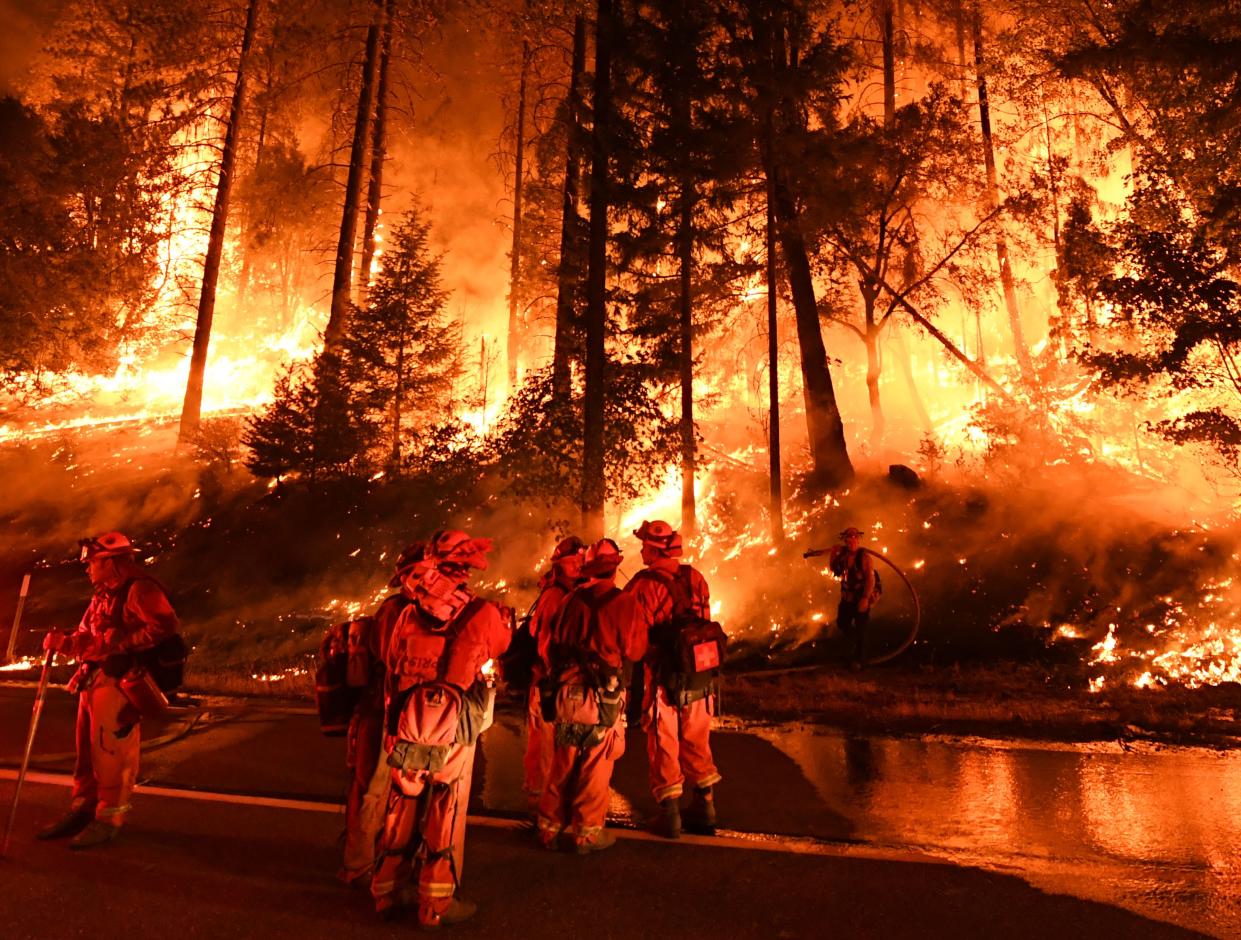Cal Fire official on Trump's wildfire theories: 'I don’t know what he's getting at'
President Trump’s claim that California’s environmental policies are preventing firefighters from accessing enough water to stop the state’s wildfires has been roundly dismissed by experts and state officials.
Windy conditions and high heat expanded the Mendocino Complex Fire to 290,692 acres by Tuesday morning, making it the largest wildfire in the state’s history, destroying some 75 homes and forcing thousands to evacuate. Seven other major wildfires are burning in California, from Shasta County to San Bernardino County, at the same time.

Trump made the dubious claim that “readily available water” is being diverted into the Pacific Ocean for environmental reasons and blamed California Gov. Jerry Brown in a series of tweets.
“California wildfires are being magnified & made so much worse by the bad environmental laws which aren’t allowing massive amounts of readily available water to be properly utilized. It is being diverted into the Pacific Ocean. Must also tree clear to stop fire from spreading!” Trump tweeted on Monday.
Yahoo News reached out to Scott McLean, a deputy chief at the California Department of Forestry and Fire Protection (Cal Fire), to get the agency’s take on Trump’s claims and what’s actually happening in the efforts to stop the Mendocino Complex and other wildfires. He outright rejected the assertion that firefighters do not have enough water to handle the current wildfires.

“No, that is untrue. There are bodies of water. There are lakes near the Carr Fire: the Shasta Lake, the Whiskeytown Lake that’s surrounded by the fire, Trinity Lake — we have plenty of water, Sacramento River is just to the east,” McLean said. “On your Mendocino Complex, it’s wrapped around Clear Lake. It’s got Mendocino Lake, Berryessa Lake, and it has a river close by, so there are absolutely no water issues.”
We asked why Trump was saying that the state’s water is being redirecting into the ocean and where that idea originated.
“I cannot speak to that. I don’t know what he’s getting at. I have no idea,” McLean said. He added that California’s water policy has had “no effect to our water supply.”
On top of calling climate change a hoax, Trump has been critical of the U.S. Forest Service’s forest fire prevention campaign with Smokey Bear.
Who is paying for that tedious Smokey Bear commercial that is on all the time – enough already!
— Donald J. Trump (@realDonaldTrump) January 8, 2015
Kate Poole, the senior director of the Natural Resources Defense Council’s (NRDC) water division, said it’s hard to know where to begin in responding to Trump’s tweets because they’re fundamentally wrong on many levels. She said the firefighters have plenty of water, adding that the fires are a manifestation of the effects of climate change.
“These fires are what it means in the West to live with higher temperatures, less snowpack and more frequent and intense droughts. All of those problems are a result of climate change. Where’s the president’s outrage about that? We’d even settle for a coherent policy to tackle it, rather than make it worse,” Poole told Yahoo News.
She said Trump, in complaining about water “diverted” to the Pacific, seems to not understand that rivers flow downhill toward the ocean. On the contrary, she said, California diverts so much water from its natural path and into artificial canals that many miles of rivers have dried up completely. She said this caused ecological collapse in the San Francisco Bay-Delta estuary, the largest estuary on the west coast of the Americas.

“That’s not good for anyone — the people who live on these waterways, the people who rely on these waterways for healthy drinking water (e.g. low flows are contributing to increasing toxic algae outbreaks in the Delta), or the people who rely on healthy salmon runs for their livelihood,” Poole said. “The president seems to want to worsen these problems by diverting even more water away from the natural system to benefit corporate agriculture at the expense of everyone else.”
Accounting for dams and diversions, California’s water officials have been putting together proposals that would return a degree of “unimpaired flow” to return certain waterways, such as the San Joaquin River, to help native fish populations.
Slideshow: Deadly wildfires in Northern California >>>
Northern California has been dealing with 100-degree weather for more than a month. Even before the heat wave, the vegetation — trees, brush, grass — was already extremely dry and highly vulnerable to fire. There have been erratic winds, and the humidity doesn’t rebound at night as it did years ago, so it can burn just as intensely at night as it does during the day, McLean said.
“We’re well ahead of our drying cycle by over two months,” he continued. “Firebrands, embers, sparks. It doesn’t take really anything to start a fire in the state right now.”
McLean said wildfire seasons like this one are becoming the norm.

“We were saying that last year. This is the normal currently. This is what we’re living. Everybody in the state needs to be responsible because it affects everybody.”
House Democratic leader Nancy Pelosi, who represents San Francisco, released a statement expressing sympathy for the nine people killed in the current wildfires and calling on Trump to expand a major disaster declaration for Shasta County to cover other counties affected by the fires.
“The Administration also must start taking real, urgent action to combat the threat of the climate crisis, which is making the wildfire season longer, more expensive and more destructive,” Pelosi said.
The U.S. Army is preparing to send 200 active-duty soldiers to fight fires in the West this week.
_____
Read more from Yahoo News:

